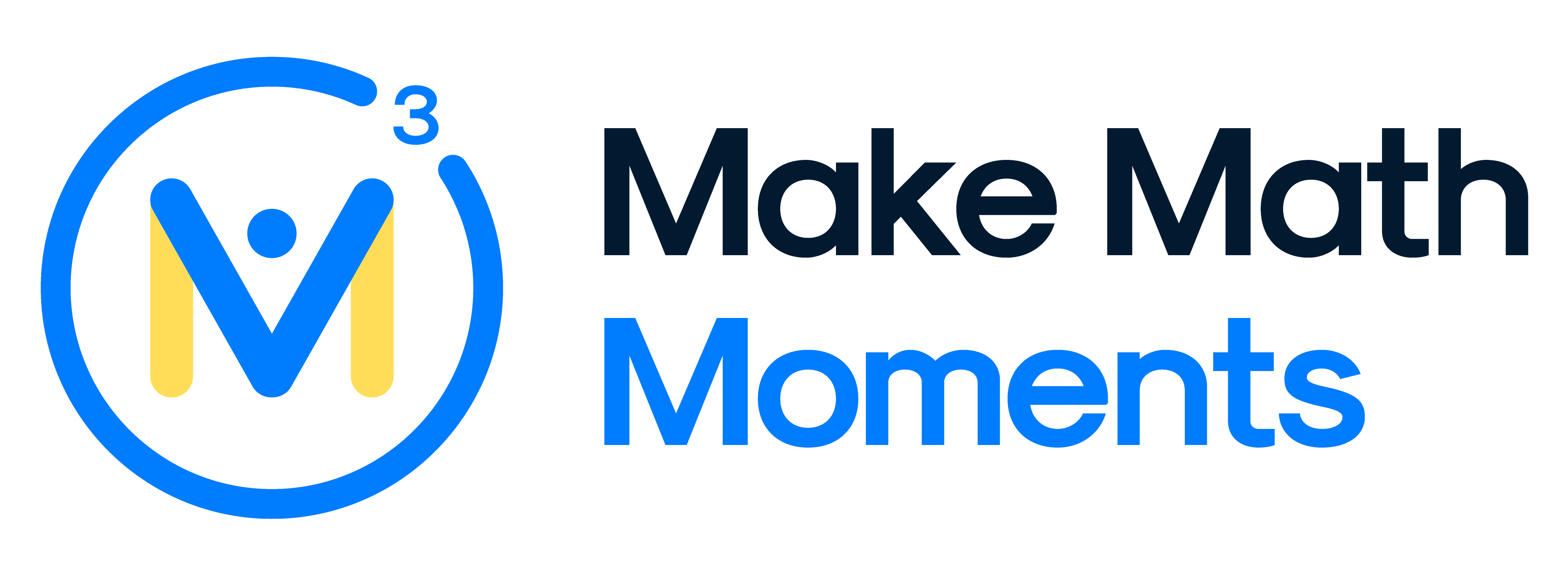ARMY OF ANTS [DAY 3]
SUBTRACTION STRATEGY: ROUND THE SUBTRAHEND AND ADJUST
Explore efficient strategies to subtract values within 50
Intentionality
Spark Curiosity
Fuel Sensemaking
During Moves
Student Approaches
Next Moves
Consolidation
Reflect and Consolidation Prompts
Resources & Downloads
Educator Discussion Area
Intentionality & Unit Overview

Length of Unit: 5 Days
Access each lesson from this unit using the navigation links below
Students will solve a subtraction question using the take away strategy of decomposing the subtrahend.
Intentionality…
In this task, students will engage in a subtraction context and lead towards the “round the subtrahend and adjust” strategy.
Some of the big ideas that may emerge through this task include:
- Subtraction names the missing part in terms of the whole
- Different subtraction situations will elicit different strategies
- Number relationships provide the foundation for strategies to help students remember basic facts
- Efficient operational sense strategies should be number oriented
- Subtraction can be used in either take away, comparison, or missing addend situations. Take away is explored in this task.
- Subtraction represents the difference or space between two numbers
Models can be used to connect concrete to abstract
Spark Curiosity
What Do You Notice? What Do You Wonder?
Show students the following video:
Then, ask students:
What do you notice?
What do you wonder?
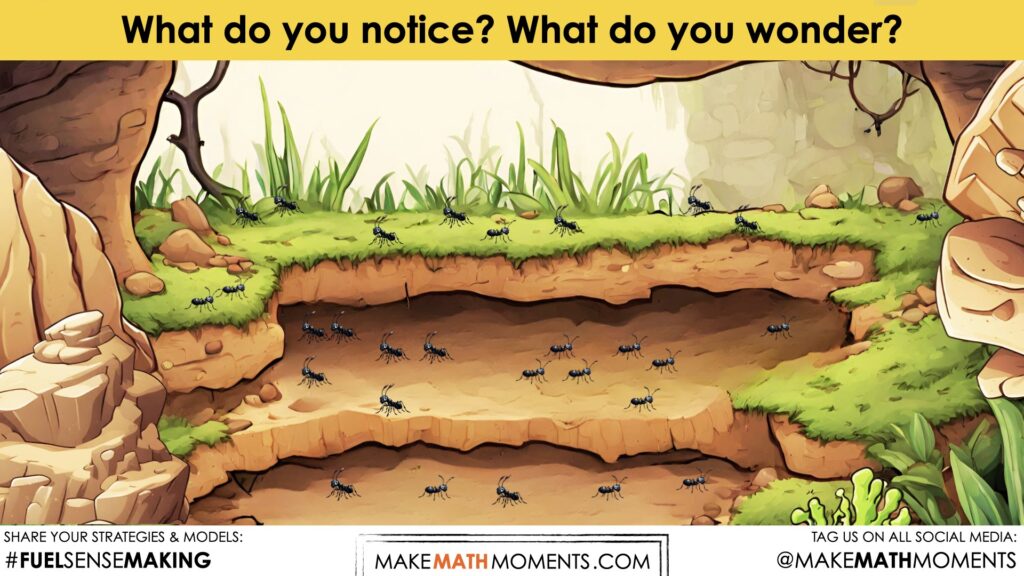
Give students about 30-60 seconds to do a rapid write on a piece of paper or silent individual think time.
Replaying the video can be helpful here if appropriate.
Then, ask students to pair share with their neighbors for another 60 seconds.
Finally, allow students to individually share with the entire group. Be sure to write down these noticings and wonderings on the blackboard/whiteboard, chart paper, or some other way that is visible to all. This helps students to see the thinking of their classmates and ensures each student that their voice is acknowledged and appreciated. Adding student names or initials next to their notice/wonder is one way to acknowledge their participation and can motivate others to join in.
Some noticings and wonderings that may come up:
- I notice that there are a lot of ants
- I notice that ants are coming into the colony
- I notice ants are leaving the colony
- I wonder what the ants are doing
- I wonder how many ants there are in the colony
Fuel Sense-making
Crafting A Productive Struggle: Prompt
Since we’ve already invested time to set the context for this problem and student curiosity is already sparked, we have them in a perfect spot to help push their thinking further and fuel sense making.
At the end of a long day, 28 worker ants leave the colony for one last food mission. If there were 53 worker ants to begin with, how many of them are still in the colony?
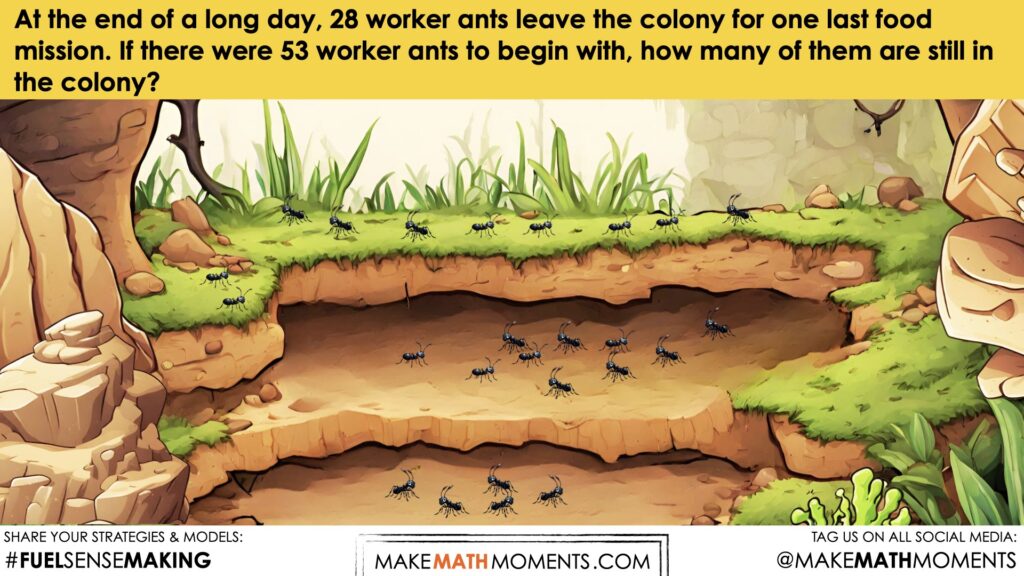
Here we are asking students to envision a solution path. By considering what information will be needed and how it can be used to solve the problem, students are being asked to make sense of the problem and reason abstractly and quantitatively. By not simply providing this information, we are inducing students to engage more deeply with the problem and think about all of its parts, known and unknown, before they begin crunching the numbers.
During Moves
While Students Are Productively Struggling…
Monitor student thinking by circulating around the room and listening to the mathematical discourse. Educators are looking for students that are making their thinking visible so it can be displayed during consolidation. Select and sequence some of the student solution strategies and ask a student from the selected groups to share with the class from:
- most accessible to least accessible solution strategies and representations;
- most common misconceptions;
- most common/frequent to least common/frequent representations; or,
- choose another approach to selecting and sequencing student work.
The strategies you might see students use include:
- Direct Modeling and counting with a drawing
- Counting back
- Adding up to find the difference
- Decomposing the subtrahend using a number line
- Rounding the subtrahend and adjusting
Assessment:
This checklist can be used for tracking formative assessment as students are working. The information collected can be used to form whole group, small group or one-to-one support models.
Student Approaches
Student Approach 1: Using a Tool to Direct Model and Count All
Login/Join to access the entire Teacher Guide, downloadable slide decks and printable handouts for this lesson and all problem based units.
Student Approach 2: Adding up using an open number line
Login/Join to access the entire Teacher Guide, downloadable slide decks and printable handouts for this lesson and all problem based units.
Student Approach 3: Open Number Line to decompose the subtrahend
Login/Join to access the entire Teacher Guide, downloadable slide decks and printable handouts for this lesson and all problem based units.
Student Approach 4: Round the Subtrahend and Adjust
Login/Join to access the entire Teacher Guide, downloadable slide decks and printable handouts for this lesson and all problem based units.
Next Moves
Reveal
Show students the following reveal video:
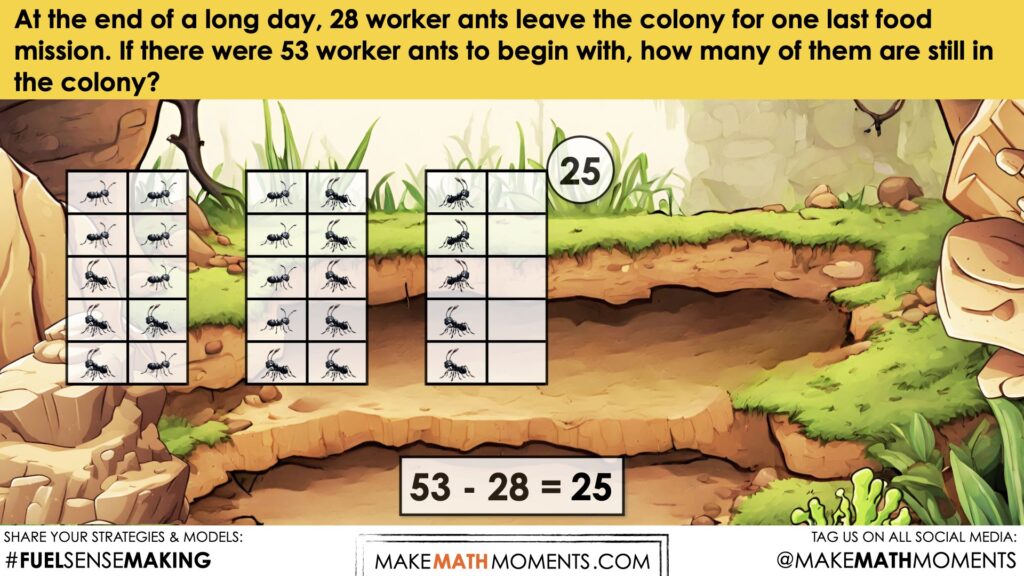
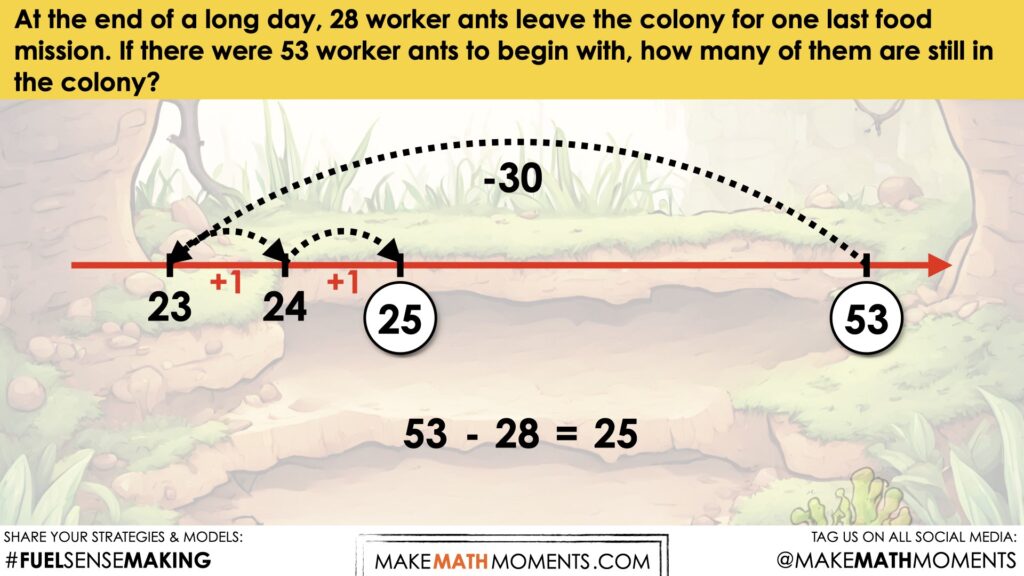
Consolidation
Consolidation: Making Connections During Classroom Discourse
Login/Join to access the entire Teacher Guide, downloadable slide decks and printable handouts for this lesson and all problem based units.
Reflect and Consolidation Prompts
Rounding the subtrahend and adjust is an effective way to subtract mentally. This strategy is most effective when the subtrahend is just under the decade number.
Provide students an opportunity to reflect on their learning by offering these consolidation prompts to be completed independently and then discussed as a class.
Consolidation Prompt #1:
Login/Join to access the entire Teacher Guide, downloadable slide decks and printable handouts for this lesson and all problem based units.
Consolidation Prompt #2:
Login/Join to access the entire Teacher Guide, downloadable slide decks and printable handouts for this lesson and all problem based units.
We suggest collecting this reflection as an additional opportunity to engage in the formative assessment process to inform next steps for individual students as well as how the whole class will proceed.
Resources & Downloads
Login/Join to access the entire Teacher Guide, downloadable slide decks and printable handouts for this lesson and all problem based units.
Printable Lesson Plan PDF
Videos, Images & Media Files
Apple Keynote Presentation
Powerpoint Presentation
Printable Consolidation Prompts
Educator Discussion Area
Login/Join to access the entire Teacher Guide, downloadable slide decks and printable handouts for this lesson and all problem based units.
Explore Our 60+ Problem Based Units
This Make Math Moments Lesson was designed to spark curiosity for a multi-day unit of study with built in purposeful practice, number talks and extensions to elicit and emerge strategies and mathematical models.
Dig into our other units of study and view by concept continuum, grade or topic!
